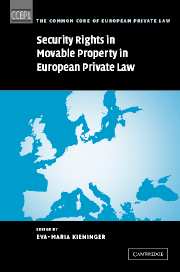Book contents
- Frontmatter
- Contents
- General editors' preface
- Preface
- List of contributors
- Table of cases cited by name
- Table of legislation
- Part I Introduction and context
- Part II The case studies
- List of abbreviations
- Bibliographies
- Glossary
- Case 1 Furniture for a new office
- Case 2 The deceived seller
- Case 3 Machinery supplied to be used by the buyer
- Case 4 Jackets for resale
- Case 5 Motor cars supplied and resold (I)
- Case 6 Motor cars supplied and resold (II)
- Case 7 Supply of material to manufacturer (I)
- Case 8 Supply of material to manufacturer (II)
- Case 9 Too many toasters
- Case 10 Bank loan on the basis of a car fleet
- Case 11 Bank loan for a wholesaler
- Case 12 Bank loan on the basis of money claims (I)
- Case 13 Bank loan on the basis of money claims (II)
- Case 14 Finance leasing of computers
- Case 15 Indebted businessman sells business to brother
- Evaluation: a common core? Convergences, subsisting differences and possible ways for harmonisation
- Index by country
- Index by subject
Case 13 - Bank loan on the basis of money claims (II)
Published online by Cambridge University Press: 23 December 2009
- Frontmatter
- Contents
- General editors' preface
- Preface
- List of contributors
- Table of cases cited by name
- Table of legislation
- Part I Introduction and context
- Part II The case studies
- List of abbreviations
- Bibliographies
- Glossary
- Case 1 Furniture for a new office
- Case 2 The deceived seller
- Case 3 Machinery supplied to be used by the buyer
- Case 4 Jackets for resale
- Case 5 Motor cars supplied and resold (I)
- Case 6 Motor cars supplied and resold (II)
- Case 7 Supply of material to manufacturer (I)
- Case 8 Supply of material to manufacturer (II)
- Case 9 Too many toasters
- Case 10 Bank loan on the basis of a car fleet
- Case 11 Bank loan for a wholesaler
- Case 12 Bank loan on the basis of money claims (I)
- Case 13 Bank loan on the basis of money claims (II)
- Case 14 Finance leasing of computers
- Case 15 Indebted businessman sells business to brother
- Evaluation: a common core? Convergences, subsisting differences and possible ways for harmonisation
- Index by country
- Index by subject
Summary
(Security right to a claim against a debtor whose identity is unknown at the time the security right is created – rights of the secured party in execution)
B, an engineer, is a sole trader. He wishes to expand his business. As security for a bank loan from A, he can offer only the claims that will arise against future customers who, at the present time, are unidentified.
Questions
(a) Is there an arrangement by which B can grant to A a security in his claims against future customers? If so, describe its main features and prerequisites. How common are agreements of this kind in business practice?
(b) After concluding the security agreement with A, B acquires a claim against customer D worth 3,000 Euros. A bailiff wishes to execute against that claim on behalf of an unsecured creditor of B. Who has priority, A or the unsecured creditor? On what further circumstances does A's right depend (e.g. communication of the assignment to D, revocation of B's entitlement to collect the claims against his customers)?
(c) B becomes bankrupt, having outstanding claims worth 10,000 Euros against customers C1–C5. Does A have any rights in respect of these claims? On what further circumstances do any rights of A depend (e.g. communication of the assignment to C1–C5, revocation of B's entitlement to collect the claims against his customers)?
(d) If B grants to A a security right in all his claims against his customers, are there any limits as to the value of the collateral in relation to the amount of the secured loan?
- Type
- Chapter
- Information
- Security Rights in Movable Property in European Private Law , pp. 573 - 594Publisher: Cambridge University PressPrint publication year: 2004



